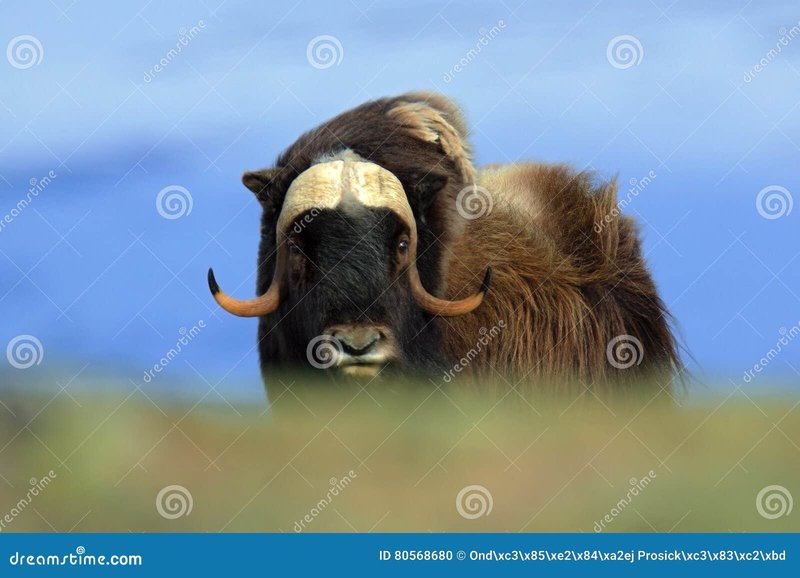
Picture this: you’re trekking through the tundra, the wind howling around you, and there they are—muskoxen grazing peacefully. But, as with any wild animal, there’s a flip side to their calm demeanor. Let me explain what makes muskoxen fascinating and sometimes potentially dangerous.
What is a Muskox?
Muskoxen are large, shaggy mammals that roam the Arctic tundra, primarily found in parts of Canada, Greenland, and Alaska. They’re known for their thick, long fur, which protects them from the freezing cold. In fact, their wool, called qiviut, is one of the warmest fibers available. This means they’re well-adapted to survive harsh climates, which makes them quite resilient.
These animals have a unique appearance, resembling a mix between a bison and a goat. They can weigh up to 800 pounds and stand about 4 to 5 feet tall at the shoulder. Their curved horns can grow to be quite impressive, measuring up to 30 inches. But don’t let their size fool you; muskoxen are herbivores, primarily feeding on grasses, mosses, and willows.
While they may look endearing, it’s essential to remember that they are wild animals. Their natural instincts, especially when threatened, can make them unpredictable in certain situations.
Are Muskoxen Aggressive?
Muskoxen are generally not aggressive creatures. However, they are known to react defensively if they feel threatened. When they perceive danger, they tend to form a tight circle with their young and face outward, which can look imposing. This defense mechanism helps protect their vulnerable calves from predators, including wolves and Arctic foxes.
You might be wondering what could trigger a muskox to act aggressively. It often relates to encounters with humans. If approached too closely, especially during mating or calving seasons, they might charge or stampede. This behavior is more about self-preservation than actual aggression, but it can still be dangerous.
In rare cases, muskoxen have attacked humans, but these incidents are typically linked to a perceived threat. Protecting their territory or young can lead to unexpected confrontations, so it’s essential to keep a safe distance if you ever come across them in the wild.
When Do Muskoxen Become Dangerous?
The chances of a muskox becoming dangerous to humans are relatively low, but certain situations can escalate. For example, during the calving season, when mothers are fiercely protective of their young, it’s best to steer clear. If you come across a herd with calves, it’s wise to give them plenty of space.
Another time to exercise caution is during the rutting season, which occurs in the fall. Male muskoxen can become quite aggressive as they compete for mates. This behavior can lead to jousting matches with their horns, and while they usually target each other, humans nearby might inadvertently get caught in the crossfire.
Additionally, muskoxen that are accustomed to human interaction might exhibit different behaviors than their wild counterparts. They might no longer fear humans, becoming bolder and more unpredictable. Observing them from a safe distance is key to avoiding unnecessary risks.
How to Safely Interact with Muskoxen
If you find yourself in muskox territory, knowing how to interact safely is crucial. Here are some tips:
- Maintain a Safe Distance: Always stay at least 50 yards away from muskoxen. Use binoculars for a closer view instead of approaching.
- Observe Quietly: Avoid loud noises or sudden movements that could startle them. Calmness is key.
- Watch for Body Language: If a muskox raises its head, snorts, or moves toward you, it’s time to back off.
- Don’t Corner Them: Make sure they have an escape route if they feel trapped. Never block their path.
Following these guidelines will help ensure both your safety and the well-being of these fascinating animals.
Comparing Muskoxen to Other Wildlife
When discussing dangerous wildlife, muskoxen often get compared to other animals like bears, moose, or even bison. Each of these creatures has its own behavior patterns and danger levels.
For instance, while bears are highly territorial and can pose a significant threat when surprised, muskoxen are typically more passive unless provoked. Similarly, moose can be unpredictable, especially during mating season, while bison are known to charge if they feel threatened.
In contrast to these animals, muskoxen usually want to avoid confrontation. Their defensive behaviors are primarily protective rather than aggressive. Understanding these differences can help us appreciate muskoxen for what they are and avoid any misconceptions about their nature.
The Importance of Respecting Wildlife
Respecting wildlife, including muskoxen, is vital for conservation efforts. These animals play a significant role in their ecosystem. By grazing, they help maintain the balance of plant life in the tundra. Plus, protecting their habitats ensures future generations can appreciate these remarkable creatures.
Human interactions with wildlife can have lasting impacts. If muskoxen feel threatened by human presence, they may alter their natural behaviors, which can lead to population declines over time. Therefore, it’s essential to promote safe wildlife viewing practices to help preserve their natural environment.
Ultimately, understanding how to coexist with muskoxen and respecting their space can lead to a more harmonious relationship between humans and these ancient animals.
So, can muskoxen be dangerous to humans? They’re not typically aggressive, but like any wild animal, they have their moments. It all comes down to respecting their space and understanding their behavior. By maintaining a safe distance and observing from afar, we can appreciate these unique creatures without putting ourselves or them at risk.
Next time you hear about muskoxen or spot one in the wild, remember the fascinating balance of nature and how our actions can impact these incredible animals. Embrace the adventure, keep your distance, and enjoy watching these true survivors of the tundra.

